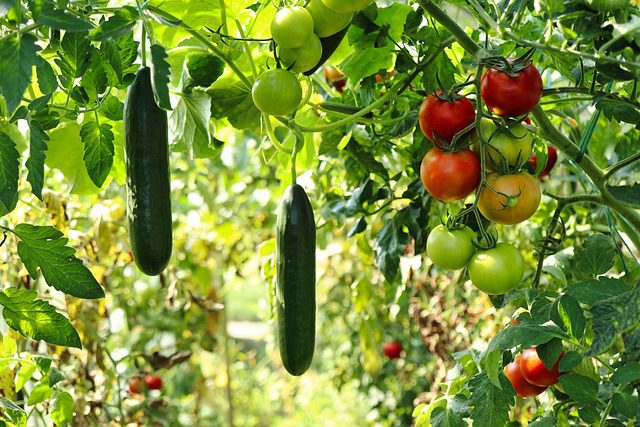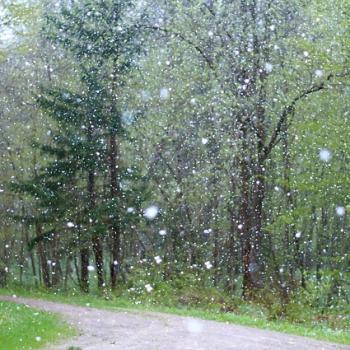
Let’s talk about growing a garden!
My veteran readers certainly know that gardens are my favorite thing. But it struck me that I usually just write long poetic pieces about enjoying my garden. I’ve never sat down and written a piece that was just information on how to grow an organic garden of your own, especially if you’re always broke like me and don’t have many resources. So this post isn’t poetry, this is information.
It is not true that everyone can grow their own fancy organic food. You never want to be one of those irritating Karens who chide people that they’re not trying hard enough if they don’t have a permaculture homestead. There are all kinds of reasons that a person might not be able to grow their own backyard garden like I do. But I do get irritated by those memes about silly people who spend hundreds of dollars on growing their own tomatoes to save twenty bucks at the grocery store. If you learn how to garden on a shoestring, it actually is a very economical way to get some good food and a lot of satisfaction, if you have time and a yard and if you plan it out right. So this technique won’t work for everyone, but it’s brought me a lot of joy for a very low price, and you might find it works for you.
The first step in organic permaculture backyard gardening, is to tell yourself a hundred times that the perfect is the enemy of the good.
Maybe get that phrase tattooed on for good measure. The perfect is the enemy of the good. Unless you’re filthy rich with an enormous plot of land and twenty-five hours in every day, you cannot be 100% fussy organic and unproblematic. You’re going to have to make compromises, while still moving in the best direction you can. We all do that. For example, I buy supplies on Amazon and at Walmart all the time. I have to. I don’t have unlimited funds or time to drive for an hour. I patronize small family-run nurseries and seed banks whenever I can. I ask for trellises and tomato cages in the Buy Nothing group. But sometimes, I simply have to buy a shovel and some peat pots from Jeff Bezos. That’s the best I can do. If your best is better than mine, good for you. But no one should be intimidated out of taking a few good steps because you don’t think you can do things exactly right.
After you’ve learned your mantra, the next step is to prepare your patch.
The best time to do this is fall right before frost, for gardening next year, or in early spring two weeks before planting season because you forgot. All you have to do is select a spot in the yard that is sunny most of the day, and cover the grass with flat sheets of cardboard. A couple of collapsed Chewy boxes work well. Weigh that cardboard down with bricks or something and just leave it alone for a minimum of two weeks. That will kill off the grass naturally and start it decomposing, while softening the soil and providing a feast for the beneficial earthworms. And it didn’t cost any money, and hardly any work.
Once you’ve covered your patch, look around at the rest of your yard. Is the grass perfectly smooth without weeds? That’s bad. You need pollinators to boost the garden’s yield, and pollinators won’t come if there’s nothing for them to eat. Your crops are going to be miserable. You’ve got to make your yard into a healthier biome. And I promise you don’t have to do that by turning into one of those weirdos who ends up on the news after making their yard a gigantic unsanitary mess. Just stop putting pesticide on your lawn, and let some clover, dandelions, plantain and Creeping Charley take over. Sow some seed in the grass to get them started if you’d like. Yes, you can actually buy dandelion seed, though you probably don’t need to. And I found out that you can buy clover seed at any store where they sell hunting supplies, because people who hunt deer will sow clover to attract them. Those are the low-growing wildflowers that work well on lawns in my particular climate here in Zone 6. You’ll have to find the right plants that work for you where you are. Don’t let them grow up so big and raggedy that they become an eyesore and get you a ticket from the ordinance officer. Just let them grow up a little more raggedy than you’re used to before mowing. This will attract the bees and bugs who will do most of the work pollenating your garden for you. And a lawn dotted with little flowers actually is beautiful and pleasant to walk on.
When it’s time to plant, take the cardboard off your garden and turn over the soil. I always want to rent a tiller for the day to do this, but I end up using my shovel every year. You can get a shovel for about twenty bucks, and a metal-handled one will last much longer than wood. Bear in mind that if you dig up the soil right after a big rainfall it will be softer but VERY heavy. If you see any of these pupae in the soil, throw them out. Those are squash borers and they ruin everything. But leave the earthworms alone because they’re good for a garden. For the first year of your organic garden, you’ll probably need to use a fertilizer on the soil after you dig it up. Afterwards you’re going to make your own fertilizer with compost, which we’ll talk about next. I liked to use this organic fertilizer when I was getting started. It’s mostly made of chicken manure and bone meal. Now your patch is all ready to plant!
Before we get into planting: compost! Next to pollinators, compost is the most important thing.
Compost will feed your plants and boost their yield. and you can make it yourself for free, but you have to be careful about how you do it. If you just heap your garbage somewhere, it will stink and attract rats and you’ll get in trouble with your neighbors again. But here’s the method I’ve come up with which has no bad smell and is very discreet, and I don’t even use a hopper. The first thing you have to do is fill your kitchen compost bucket with your vegan kitchen waste: coffee grounds and filters, potato peels, leftover rice and pasta, apple cores and such. You can also put in eggshells which add good calcium to the soil, but eggshells can have E. Coli so I microwave them for thirty seconds first. Every few weeks I also add a single, fully cooked, chicken or fish bone for a little more calcium. When the bucket is full, put it in the compost, but don’t leave the old food on the top. Instead, cover it with cardboard or with a big heap of the clippings from your lawnmower, or a stack of weeds you pulled from the garden. Keep layering your lawn mowings and garden weeds over the kitchen waste. Layer it up like a trash lasagna, but always with fresh grass or cardboard on top so no food waste is visible. If you have a guinea pig or other small vegetarian pet, the manure and dirty hay from the guinea pig cage can go into the heap with the food waste. And if you have a farmer friend or a friend with backyard chickens, ask for a bit of manure to put in with the food waste. Manure gets a compost heap decaying almost like sourdough starter turns dough into bread. Every week or so, turn over the whole pile of compost with your shovel and put a new neat layer of weeds or cardboard over the top. By this method, the compost will heat up feverishly hot and decay quickly with no stench and no varmints. You’ll see beautiful mushroom roots and earthworms all through it when you turn it over. And within about three months, the very bottom of your heap won’t be kitchen waste anymore. It will be chocolatey black soil. You can spread that soil on the garden for the best possible fertilizer.
Now, you’ve got your garden patch. You’ve started your permaculture lawn. You’ve started on your compost. It’s time to plant. What do you plant?
I can’t tell you, because I don’t know what part of the country you live in, but Google knows and it’s free. Here are some maps of gardening zones so you know when the planting season starts near you. Here’s the almanac, where you can search by your zip code and find the proper planting dates for whatever you’d like. And, in my experience, the best way to find out how to grow a new crop is to google “how to grow XYZ in your yard” or “can you grow zucchini in zone 6,” and “why is my zucchini rotting” and such, and let all the different gardening experts tell you. Remember, gardening isn’t some kind of instinct some people have and some don’t. Gardening is a skill that you learn because somebody taught you. Other people have been through the process you’re going through now and learned techniques. Read up, and get started. Remember that you are not a failure if you just go to Walmart to grab some peat pots to start tomato seedlings indoors, or BUY some seedlings for that matter. Walmart has a couple of good heirloom tomato plants in among the boring flavorless ones. Depending on where you live, you could buy garden vegetable and fruit plants at the grocery store with food stamps. If you happen to live in Eastern Ohio, I can tell you that tomatoes grow well here. A Three Sisters patch is also great, but you’ve got to start the winter squash with a good seedling instead of just planting seeds straight in the ground because otherwise, the corn will grow too fast, overshadow the squash, and you won’t get any fruit. Summer squash usually grows well if you water carefully and watch out for squash bugs. Rosemary is the easiest thing in the world to grow. Mint is a weed but it smells great. I’ve never had any luck with eggplant or cauliflower. But, everybody’s gardening zone is going to be different.
When buying seeds: in my experience, it actually is better to buy fussy organic heirloom seeds instead of a packet as an impulse purchase. When I buy a packet of sunflower seeds I see at the Dollar Tree, for example, only about a quarter of them ever germinate. But when I get good heirloom seeds, those all tend to germinate and grow very strong plants. In fact, in 2023 I composted the heirloom sunflowers I’d grown from the special seeds after the season was over, and those dried out sunflower heads grew new plants right out of my compost heap so I had about twenty free seedlings the next year, the hardiest seedlings I’d ever grown. This year I have a whole wall of sunflowers on the north side of my garden, and I didn’t pay for any of them. So, seeds are the one place where I’d advise getting the fussy kind. Thankfully, there is a free seed bank that will send you heirloom seeds in small quantities perfect for a backyard, for the cost of shipping!
Now you’ve got your plants. You’ve got your soil, your sunshine, your pollinators and your free fertilizer from the compost, all on a shoestring budget. The last step is watering. I have seen so many people wasting money by just spraying their hose over the top of the entire garden patch like they’re watering the lawn, and it drives me crazy. Watering is expensive and you can hurt the plants if you do it the wrong way. One way to save water starts when you’re planting: learn by trial and error how to plant your seedlings closer together than you think you should, to shade the soil so you don’t need to water as often. A crammed garden patch is more economical than one with lots of room. Also, don’t be afraid of weeds. Don’t let the weeds run rampant and take over, but a bit of wild plantain and clover between the tomato cages is actually a good thing because they also shade the soil and keep it from drying out. Another way to save water is to only water the ROOTS of plants, instead of spraying the hose everywhere and soaking the whole plant. Plants don’t drink through their leaves. Try to only water at dawn or sunset, or both if it’s extremely hot, so the water is actually soaking into the soil instead of evaporating into the air at the hottest part of the day. For a plant that guzzles a lot of water, like a tomato or a cucumber, I usually get the seedling started by drenching the soil several times with a gallon jug. A planter can get overfull of water and rot the plants, but the ground doesn’t do that. The ground just keeps soaking, so the soil stays moist for a very long time.
That should be enough information to get you started! It’s fun and rewarding to grow an organic permaculture backyard garden and share your produce with the neighborhood! And it doesn’t have to cost a lot of money. You just have to know what you’re doing, and the best way to do that is to start gardening and see where it takes you.
Mary Pezzulo is the author of Meditations on the Way of the Cross, The Sorrows and Joys of Mary, and Stumbling into Grace: How We Meet God in Tiny Works of Mercy.













